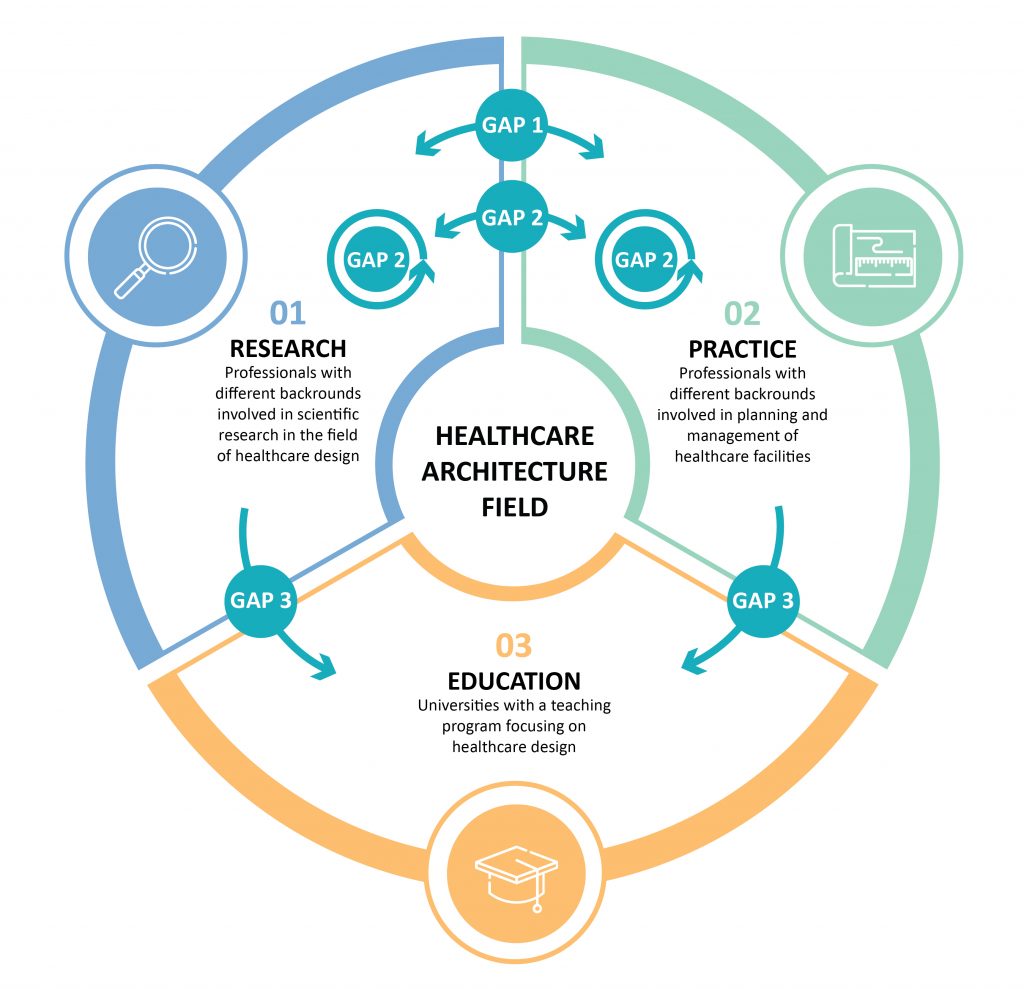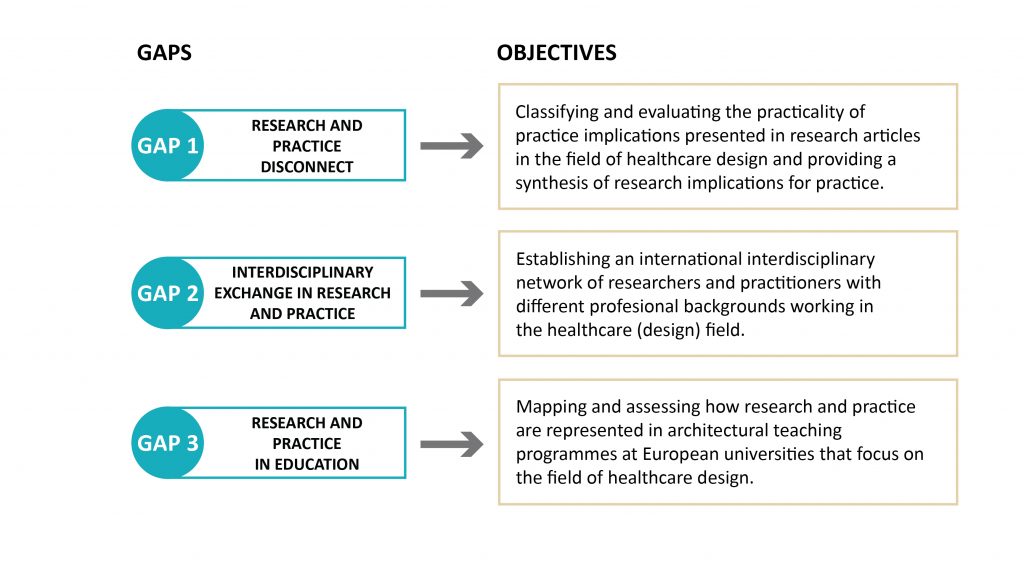Examining the healthcare architecture field
Assessing the interrelationships between architectural education, practice, and research
This project addresses the gaps between three interconnected aspects in the field of healthcare design – architectural education, research and practice. Healthcare design is one of the most critical domains within the field of architectural design. Its significance stems from the profound impact that the physical attributes of healthcare settings can have on people’s health outcomes. Over the years, an extensive body of research has been established, building upon Ulrich’s groundbreaking study in 1984. This research unequivocally demonstrates that the built environment of healthcare facilities significantly impacts health outcomes such as infection control, speed and success of patients’ recovery, activity levels, overall well-being, and satisfaction of all stakeholders involved, including medical staff, patients’ families, and visitors. This comprehensive body of evidence has paved the way for the emergence of a specialized field known as Evidence-Based Design (EBD). Therefore, EBD studies examine the relationship between specific architectural aspects of healthcare and various health outcomes. By implementing research findings and incorporating resulting design recommendations into real-life projects, the aim is to create healthcare environments that foster faster recovery, improved psychological well-being, and overall better healthcare experiences.
Even though the EBD field shows great promise for improving healthcare environments, there is still a large disconnect between architectural research and application in practice, especially in European countries. Multiple factors contribute to this disconnect:
- GAP 1 – Research and Practice:
Practitioners in healthcare architecture often criticize research in the field for having a narrow focus and offering isolated, fragmented and sometimes conflicting results that are difficult to understand and apply in design practice.
- GAP 2 – Interdisciplinary Exchange:
There is a lack of interdisciplinary exchange between different professions in the field, such as medical professionals, architects and designers, hospital management and engineering professionals and so on. Professionals of each field hold important, focused and fragmented knowledge that is not integrated and used to improve the design of healthcare facilities.
- GAP 3 – Research and Practice in Education:
Based on the previous work of the Design & Health lab, gaps in architectural education were identified. It was found that many practitioners and researchers in the field of healthcare architecture in Italy have not received relevant education during university training. Furthermore, there is a disbalance of the representation of research and practice in architectural education related to the healthcare field in different universities.

Activities in Phase 1
Exchange and Strategy Planning
In the first steps, three months were spent at the Design & Health Lab to exchange research and design knowledge and become familiar with each other’s approaches. During the first visit period, the following activities were completed:
- Introduction to the research and teaching work of the lab and all different research topics that the lab members are investigating
- Independent lecture in the course SMART hospital entitled „Introduction to research in healthcare design“
- Independent lecture in the postgraduate master course Pianificazione, programmazione e progettazione dei sistemi ospedalieri e socio-sanitari entitled „Exploring neurological rehabilitation centers as healthcare facilities – Examples from practice and research”
- Individual review with all PhD students of the Design & Health Lab
This time was also used to develop the strategies that will be used in the research project going forward:
- Strategy for GAP 1 – Research and Practice:
A comprehensive literature review is planned to examine what implications for practice are given in research articles based on their results. The aim is twofold: to assess their practicality and to provide a synthesis of research implications for practice to be used by all involved in the process of planning healthcare facilities.
- Strategy for GAP 2 – Interdisciplinary Exchange:
An establishment of a interdisciplinary network of professionals in the healthcare field is planned for exchanging research and expertise and systematizing and making available the existing fragmented knowledge from European and other countries.
- Strategy for GAP 3 – Research and Practice in Education:
A Europe-wide research survey is planned to assess the type of programs and courses related to healthcare design and their content at Universities with Architecture programs.
Activities in Phase 2
Implementation of Strategies
All planned strategies are currently in the development process as follows:
Strategy implementation progress for GAP 1:
The literature review protocol was submitted to an international conference in the field of healthcare design, all the articles that will be included were identified, the data was extracted, and the analysis will start in the next phase. The goal is to publish the results in a journal publication.
Strategy implementation progress for GAP 2:
A COST Action proposal HoPEE “Hospital design Preparedness for Endemic and Epidemic infections”, with the Design & Health Lab as the main proposer, was submitted in October 2023. This initiative involves 33 researchers and professionals from 16 countries and various disciplines connected with the planning and operation of healthcare design.
Strategy implementation progress for GAP 3:
The survey to examine architectural education in healthcare at European universities is in the final development phase and is expected to be distributed in the following months. It is planned that the survey results will be published in the form of a journal publication
The objectives

This project has three main objectives:
- Classify and evaluate the practicality of implications for practice presented in research articles in the field of healthcare design and provide a synthesis of research implications for practice to be used by all involved in the process of planning healthcare facilities.
- Establish an international interdisciplinary network of researchers and practitioners in the healthcare (design) field.
- Map and assess the content of architectural education in the field of healthcare design at European universities, as well as how architectural research and practice are represented in teaching programmes.
This project is the first comprehensive examination of the healthcare architecture field with a broad perspective. As such, the results are expected to greatly impact the field by identifying potentials and challenges for integrating various factors contributing to the current gaps. Furthermore, it is expected that the results will have a long-term impact on improving the design of healthcare environments to improve all users’ health outcomes and well-being.



